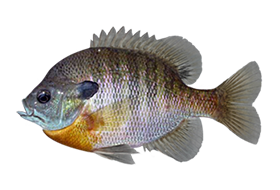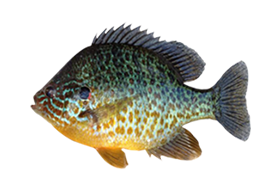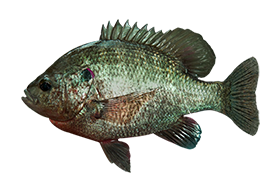A Guide for Beginner Anglers
As an angler, you may come across a variety of fish species in different bodies of water. One of the most popular freshwater fish that anglers are always keen to catch is the sunfish. Sunfish belong to the Centrarchidae family and are known for their spiny dorsal fins, sturdy build, and beautiful colors. However, not all sunfish are the same. In this blog post, we want to delve into the different types of sunfish, providing you with insights into which ones you can encounter while fishing.
1. Bluegills:
The bluegill sunfish is a small, round-shaped fish with blue-green scales on its body, an orange underside, and a dark patch on its gill cover. They have a maximum size of about 14 to 16 inches and 4 to 5 pounds. Therefore, the average bluegill will have a length of about 4 to 8 inches and an approximate weight of 3 to 12 ounces. Bluegill can be found in almost every state in the US and are a common catch for many anglers in warm, shallow water with structures such as logs, rocks, and weed beds. However, they prefer inland ponds, rivers, and lakes. They like clear, still waters and are caught using small hooks and lightweight tackle. Live bait like worms or crickets work best, or you can use small jigs or poppers.
2. Greenies:
The green sunfish is the largest species of sunfish commonly found in large rivers and lakes. They have a mottled green and gold coloration with vertical bars on their sides. Their ears are dark, and their gill covers have a white margin. The average length is 4 inches, usually 2 to 8 inches, and reaching a maximum of 12 inches, which is rare. Most weigh less than half a pound. Their range is from the Great Lakes region to the Gulf of Mexico. They prefer slow-moving streams and ponds, often with weedy areas. These sunfish are also known for being tolerant to habitat destruction and pollution, making them a hardy catch for anglers in warm, slow-moving water, such as ponds and streams. Being aggressive feeders, they will eat just about anything. Their favored baits include worms, crayfish, small minnows, and the occasional small frog. They also can be caught with lures like small jigs, spinners, and spoons.
3. Longears:
The longear sunfish is a colorful species with a vibrant orange-red belly and bright blue-green scales. They have a long, narrow head with a small mouth that gives them a distinctive “frog-like” appearance. In addition, they have a bright orange-red spot at the base of their dorsal fin and an extended, black ear tab. These sunfish may grow to 9 inches, averaging 3 to 4 inches and just a few ounces. Males grow faster and live longer than females. Their range in North America is primarily in the Mississippi and Great Lakes regions and freshwater areas west of the Appalachian Mountains in slow-moving streams with a rocky or sandy bottom. They will go after small lures, flies, live baits like worms, crickets, and grasshoppers, and artificial baits like tiny jigs with soft plastics.
4.Pumpkinseeds:
The pumpkinseed sunfish is a favorite among anglers for their beautiful colors and distinctive shape. They are usually olive to brown in color, with orange to yellow spots on their sides, a blue-black operculum (gill cover), and a red-orange underbelly. They range from 3 to 7 inches long and weigh between 4 and 12 ounces. While found in the eastern half of North America, from Nova Scotia to Florida, and in the Great Lakes region, they prefer clear water with freshwater vegetation, shallow lakes and ponds, and slow-moving streams and rivers. Anglers can catch them using small lures and live bait like earthworms, grubs, crickets, grasshoppers, pieces of crayfish, and leeches.
5. Redbreasts:
The redbreast sunfish have a reddish tint on their bellies, which pairs perfectly with their olive-colored backsides. They are known for their beautiful coloration, with males featuring bright orange bellies and blue-green backs while females tend to have a more subdued coloration. The average length of the redbreast sunfish is around 4 – 8 inches but can get as large as 12 inches. These fish species thrive in clear, fast-moving rivers and streams, making them common in the Southeastern part of the US. They tend to prefer clear, slow-moving streams with a sand or gravel bottom. Look for areas with deeper pools and rock structures for the best chance at catching them. They can be caught with live bait such as crickets, grasshoppers, waxworms, mealworms, and even canned corn. They will also go for artificial flies, small spinners, and small jigs.
6. Redears:
The redear sunfish, also known as shellcrackers, have a profile similar to bluegill but distinctive red marks on the edge of their gill cover. They have a brown or green coloration and a long, pointed pectoral fin. They can become rather large, weighing up to two or more pounds, with typical lengths between 7.5 – 9.5 inches. While native to the eastern part of North America, they are pretty popular in the southeastern region of the United States. They are particularly prevalent in Florida and the Gulf states, where the temperature range encourages year-round feeding. But they are also found in other regions such as New England, the Great Lakes, and the upper and lower Midwest of the United States. They prefer still-to-flowing water with a soft, muddy bottom and dense vegetation or structures. They feed primarily on snails, clams, and other small bottom-dwelling creatures, making them challenging to catch when using worms, crickets, or small jigs.
7. Rock Bass:
Rock bass are often confused with largemouth or smallmouth bass due to their similar appearance but are wholly different species. From a distance, they may look like a dull silver or grayish-copper shade, but when caught, their colors may vary depending on the conditions and waters in which they live. While they are not typically considered large game fish, they can grow to be 6-10 inches long. The average size of a Rock Bass Sunfish is around 7 inches. These sunfish are native to eastern and central North America and found in freshwater streams, rivers, and lakes. Their range extends from the Great Lakes region to the Gulf of Mexico and the Atlantic Coast to the Rocky Mountains. These fish are known for their hard-strike small jigs and live baits, including worms and minnows. Anglers can also catch them using fly fishing techniques such as dry flies, nymphs, and streamers.
8. Warmouths:
The warmouth sunfish is a fan-shaped fish with a large mouth and a dark brown or green coloration and possess a large mouth with an underbite. These fish range in size from 4 to 10 inches but can grow to over 12 inches in length and weigh up to 2.25 pounds. Warmouth sunfish are found throughout much of the south in the Mississippi River drainage, from the Gulf and Atlantic coasts and northward to the Chesapeake Bay, westward throughout Texas to the Rio Grande, and northward into the Great Lakes basin area. In addition, they prefer slow-moving creeks, rivers, swamps, ponds, and lakes. They will bite on various live bait, such as worms, crayfish, crickets, grasshoppers, or small jigs.
In summary, sunfish come in various types, and anglers need to understand the differences in their characteristics, habitats, and preferred food sources. Knowing these details can help you select the best bait and boost your chances of catching them when fishing. So, whether you’re reeling in a bluegill or a warmouth, we hope this blog post is informative and useful the next time you hit the water. Happy angling!
FRESHWATER TACKLE YOU MAY WANT TO TRY
For smaller mouth fish:
Size #6: Target fish include Panfish, Bluegill (Bream), Sunfish, and Crappie. Also great for Trout, Carp, White Perch, and more.
For larger mouth fish:
Size 1/0: Target fish include Largemouth Bass, Smallmouth Bass, Larger Trout, Carp, Walleye, Catfish, and more.
Barefoot Jig: Target fish include Trout (speckled and gray), Drum (red and black), Flounder, Striped and Hybrid Bass, Catfish, Largemouth Bass, Smallmouth Bass, Walleye, and more!
For larger catfish:
7/0 Catfish Circle Hook: Target fish include Blue, Bullhead, Channel, Flathead, and White Catfish.
To Purchase any of Tim Barefoot’s Tackle listed above, visit: BarefootCatsandTackle.com













